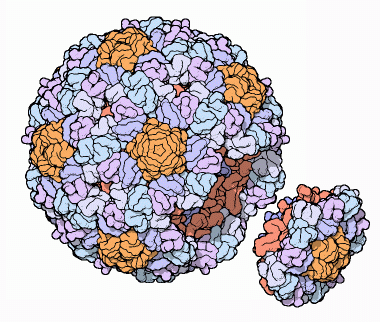|
Inhaltsübersicht | Nanomaschinen | Moleküle | Programme | Kurse | Fun | Links |
||
| > |
Bacteriophage phiX174

Assembling a Virus
As one can imagine, assembling 120 protein chains into a perfect symmetrical shell is a difficult task. PhiX174 uses special scaffolding proteins to ensure that everything ends up in the right place. The capsid and spike proteins spontaneously form pentagonal units, with five copies of each chain. The scaffolding proteins (shown here in light blue and purple) then arrange these pentagon building-blocks into the whole icosahedron, complete with DNA inside. The scaffolding proteins are small, and bind to the inner and outer surfaces of the pentagons, aligning them one next to the other in the proper orientation.
The DNA Inside
PhiX174 has the distinction of being the first organism for which a full genome sequence was determined. The virus contains one piece of DNA, 5386 bases long, wrapped into a small circle. In the mature virus, this small circle of DNA is packaged inside the icosahedral protein shell, safe for delivery to an unfortunate bacterial target. The PDB entry 1cd3 includes atomic coordinates for the capsid proteins, but the DNA inside is not included. It does not conform to the beautiful icosahedral symmetry of the capsid, and thus cannot be resolved by x-ray crystallography. We must imagine it packed inside, trapped as the last pentamer closes the capsid.Next: Exploring the Structure
Previous: Bacteriophage phiX174
Last changed by: A.Honegger,